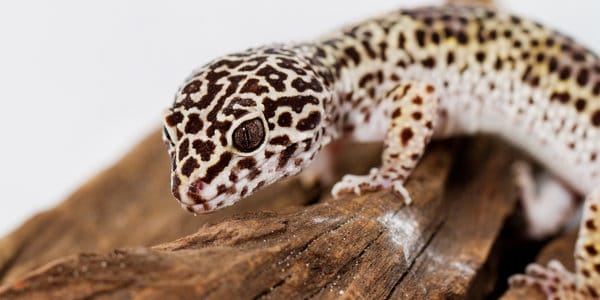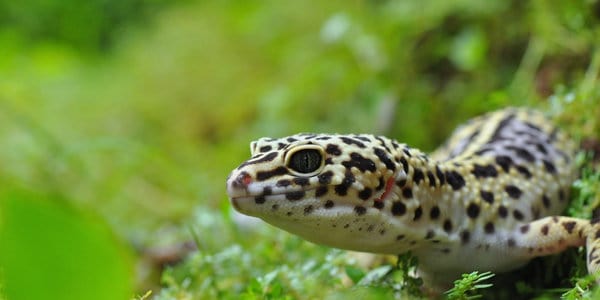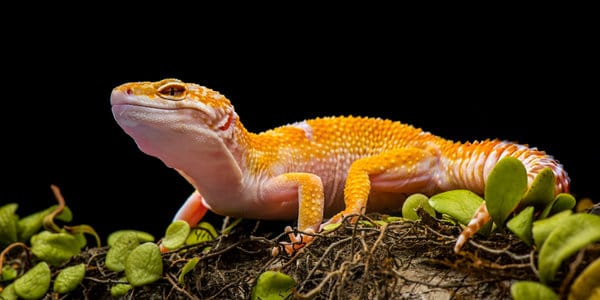Leopard geckos must be housed in enclosures with the right temperature gradient, substrate, lighting, and humidity levels. Surprisingly, most leopard gecko keepers take care of all the conditions except humidity.
So, what should a leopard gecko’s humidity be? is 50% humidity too much for a leopard gecko?
When setting up a vivarium for your leopard gecko, you must maintain humidity levels similar to those in the natural habitat. The humidity levels in a leopard gecko’s tank should range between 30% and 40%. So, 50% humidity is too much for your reptile.
If you have just brought your first leopard gecko home or planning to have one, keep reading to understand why you need to provide ideal humidity to these spotted reptiles.

Why is Humidity Essential for Leopard Geckos?
Leopard geckos are adapted to living in dry and arid areas with relatively low humidity. However, these creatures need humidity levels to be at a particular range for happy, active, and healthy living.
Essentially, humidity is crucial for leopard geckos for two reasons:
- It helps them stay hydrated and lowers the risk of infection
- Humidity helps these lizards shed properly
Most shedding problems in these scaly reptiles are associated with low humidity in their terrariums. When the moisture inside the cage is low, there is a high risk of overheating, dehydration, and shedding problems.
Conversely, low and high humidity levels are always associated with various health complications. Too much humidity increases the risk of health complications such as respiratory infections, parasitic infections, pneumonia, and skin and mouth infections.
What Is the Recommended Humidity for Leopard Geckos?
Since leopard geckos are desert dwellers from south Asia, they do well in fairly dry environments with low humidity. However, to stay healthy, active, and happy, leopard geckos need habitats with humidity levels of between 30% and 40%.
However, it’s crucial to note that this doesn’t mean that leopard geckos can’t withstand low or high humidity for a few hours. These creatures can withstand moisture levels above 20% and below 50% for a short period.
It’s worth noting that leopard geckos need high humidity levels when shedding. You must provide them with humidity levels between 70% and 80% during the shedding period. This will ensure that they get rid of the old skin without any problems.
Here is a simple tank humidity chart for leopard geckos:
| Ideal humidity range | 30% to 40% |
| Problematic | Below 30% and above 40% |
| Hygrometer | to check the humidity level |
| Ideal humidity of humid hide (for shedding) | 70% to 80% |
Measuring and Monitoring Humidity Levels in a Leopard Gecko’s Tank:
Measuring and monitoring the humidity levels inside your lizard’s enclosure is one of the most important aspects of ensuring that it’s comfortable and healthy.
When setting up your leopard gecko’s terrarium, you should invest in a hygrometer to monitor the humidity levels.
You’ll find different types of hygrometers, including traditional analog-style and digital hygrometers, in local shops and online merchants.
Regardless of the hygrometer you choose, it should be placed on cooler side so that you can measure the relative humidity.
You must take multiple readings during the day to understand how the moisture level fluctuates during the day. You can do it early in the morning, middle of the day, and evening.
When The Humidity is Incorrect
Because of changes in weather and climatic conditions, it’s not unlikely for the humidity levels inside the cage to keep fluctuating. Sometimes, the humidity can drop below 30% or increase beyond 40%.
When there’s less humidity in the cage, it can cause skin dryness, dehydration, and shedding problems.
If the humidity is too much, it can create a perfect environment for the growth of pathogens and parasites, which might cause various infections.
When there’s incorrect humidity in the terrarium, you should do everything to restore it to optimal levels of around 30% to 40%.

5 Factors To Consider When Creating a Humid Vivarium
Several factors determine how humid your leopard gecko’s terrarium is. Some factors are natural, while others can be introduced to increase or decrease the humidity levels.
The humidity levels in a leopard gecko’s enclosure will be determined by the following:
- The type of enclosure
- Temperature
- Conditions in the surrounding environment
- Types of plants used in the vivarium
- The substrate used in the tank
If you experience any problems with humidity levels in your leopard gecko’s terrarium, they may have something to do with any of these factors .
The Type of Enclosure
Leopard geckos can be housed in glass, wood, mesh, and plastic terrariums. Each type of enclosure has its pros and cons, especially when it comes to humidity.
Wooden tanks are not an ideal option, especially for beginners, since it’s difficult to maintain optimal humidity levels. These terrariums are only ideal for experienced keepers who know how to navigate the entire humidity situation. Additionally, they are prone to wear and tear and are a fire hazard.
Glass tanks are ideal since they have the benefit of holding humidity well. However, it’s crucial to ensure they have adequate ventilation to ensure that moisture levels don’t rise beyond the required range.
Mesh vivarium’s are considered great for arboreal lizards. Since leopard geckos are not, finding a suitable meshed vivarium is challenging. But if you find one, you’ll have difficulty keeping the humidity levels reasonably high throughout the day.
This is because moisture will keep escaping from the cage through the mesh and the ventilation on the sides.
Lastly, plastic tanks are cheap and can maintain optimal humidity. However, they are a fire risk, can be destroyed by heat, and don’t look as good as wooden and glass terrariums. More importantly, if you decide to go with plastic, you must ensure that they are PVC-free and non-toxic.
Temperature
Temperature and humidity go hand in hand. When the temperature increases, it causes more water to evaporate into the air, thereby making the humidity levels soar. Before you start thinking about maintaining the humidity, it’s crucial that you first set the recommended temperature range.
When setting up a leopard gecko’s terrarium, you must designate a cooler and a hotter zone. The water bowl should be on the cooler side to reduce the evaporation of more water into the atmosphere.
And since leopard geckos need high humidity when shedding, you should avoid making the entire cage humid by adding a humid hide. This will ensure that moisture inside the cage stays at optimal levels and that your lizard sheds its skin without any problems.
If humidity levels drop below 30% for an extended period, you can place a large bowl on the hotter side. The heat will vaporize more water and increase the humidity levels inside the enclosure.
Conditions in the Surrounding Environment
The humidity inside the cage will also be affected by the location, or the condition in the room where it’s placed. For instance, in coastal regions where the humidity levels are always high, the humidity inside the leopard gecko’s terrarium is also high. The same case applies to individuals living in dry areas.
Conversely, the conditions inside the room where the terrarium is placed will also impact its humidity. If the room has high temperatures and humidity levels, the leopard gecko’s cage will also have high humidity and vice versa.
Therefore, when setting up an enclosure, you should consider the conditions in the surrounding. If you come from a humid location, you must ensure that your lizard’s cage has adequate ventilation.
Conversely, if you live in less humid locations, you should reduce ventilation and find ways to increase moisture in the leopard gecko’s enclosure.
You should also consider the conditions inside the room. Luckily, most homes in the US have an average humidity of 30% and 40 %, meaning that maintaining optimal humidity inside a lizard’s vivarium won’t be that challenging.
Type of Plants in the Vivarium
Plants can also affect the humidity levels inside a leopard gecko’s cage. Naturally, live plants and mosses release moisture or water vapor into the air. When plants undergo photosynthesis, they release water in the form of vapor through a process known as transpiration.
Although plants transpire a small amount of vapor, it’s enough to cause a shift in humidity levels inside the cage.
If you often struggle with low humidity levels in your gecko’s tank, adding some live vivarium plants and mosses can help restore the moisture to optimal levels.
Conversely, you can decrease the moisture content inside the cage by switching live plants with artificial plants and vines. However, ensure that the plants you use in the gecko’s vivarium are safe, non-toxic, and don’t grow too big.
Substrates
The substrate you use in your leopard gecko’s tank can significantly influence the humidity levels. Certain types of substrates retain moisture and keep the humidity in the enclosure up. These include soil and natural mulches, such as coconut husk, cypress mulch, and orchid bark.
Conversely, some substrates don’t retain moisture and are ideal for cages that usually have high humidity levels. They include reptile carpets, paper towels, newspapers, and ceramic tiles.
Use quality moisture-retaining substrates if you live in a location with low humidity and if the cage has low moisture problems.
If your leopard gecko’s tank has higher humidity levels, use substrates that don’t retain moisture, such as reptile carpets and ceramic tiles.
Should You Mist Your Leopard Gecko’s Tank To increase Humidity?
When moisture levels drop below 30% for an extended period, misting is one of the easiest ways to increase humidity levels. Misting involves introducing moisture into the cage using an artificial tool. Usually, misting should be done in the morning and evening when it’s not too hot.
You must keep an eye on the hygrometer when misting the tank to ensure that the humidity doesn’t exceed the recommended range. You can mist the tank, the vivarium plants, and the gecko. Misting helps increase humidity levels and hydrate leopard geckos.
Are you worried whether misting will help stabilize moisture levels in the leopard gecko’s tank? It’s one of the best ways to increase humidity.

Is 50% Humidity Too Much for A Leopard Gecko?
You’ll be surprised to learn that leopard geckos can withstand up to 50% humidity. However, this doesn’t mean they will be comfortable living in a habitat with 50% humidity.
As we mentioned earlier, the ideal humidity range for these lizards is between 30% and 40%. Therefore, while your reptile friend can spend a few hours in a habitat with 50% humidity, they will become uncomfortable if they stay in such an environment longer.
As a rule of thumb, leopard geckos can only thrive and live comfortably and happily in a tank with humidity levels around 30% to 40%.
FAQs About Leopard Gecko Humidity Requirements
Which is the Optimal Leopard Gecko’s Tank Humidity Level?
Since they come from dry areas of South Asia, these lizards will live comfortably in habitats with 30% to 40% humidity.
What Is the Required Humidity for a Shedding Leopard Gecko?
While leopard geckos are active and healthy in 30% and 40% humidity, they need high humidity when shedding. You must provide your geckos with 70% to 80% humidity to shed without any problems.
How Do You Provide Leopard Geckos with Adequate Humidity to Shed?
You don’t need to make the entire cage humid to facilitate shedding. You only need to install a humid hide. The hide provides a humid environment where these lizards can retreat when they’re about to shed.
Fill the humid hide with sphagnum moss, damp soil, or peat moss to maintain the humidity around 70% to 80%.
Final Verdict
Although not many people pay attention to their leopard gecko’s tank humidity, this is one of the conditions that should be given undivided attention. Humidity helps these pesky lizards shed and stay hydrated.
Essentially, these reptile friends can happily live in habitats with humidity levels ranging from 30% to 40%. Anything below or beyond this range can lead to various health complications.